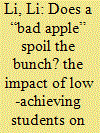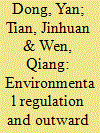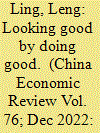|
|
|
Sort Order |
|
|
|
Items / Page
|
|
|
|
|
|
|
| Srl | Item |
| 1 |
ID:
187905


|
|
|
|
|
| Summary/Abstract |
This paper examines the relationship between the large-scale construction of broadband infrastructure and digital financial inclusion in rural China. To make causal inferences, we exploit a quasi-natural experiment and use a difference-in-differences identification strategy with a panel dataset of Chinese counties from 2014 to 2018. The results show that broadband infrastructure significantly contributes to digital financial inclusion. Furthermore, we distinguish between two dimensions of digital inclusion, namely, coverage and usage. We find that while broadband infrastructure promotes the coverage dimension, its effect on the usage dimension is limited. In addition, the effect of broadband infrastructure on digital financial inclusion in the usage dimension is larger in areas with higher levels of human capital, higher levels of social capital, and higher penetrations of bank branches. Accounting for these moderators is important to fully harness the potential of broadband infrastructure for financial inclusion.
|
|
|
|
|
|
|
|
|
|
|
|
|
|
|
|
| 2 |
ID:
187916


|
|
|
|
|
| Summary/Abstract |
This paper applies data of listed Chinese companies from 2000 to 2017 and a time-varying DID model to examine the effect of the National Development Zones (NDZs) and Provincial Development Zones (PDZs) on green innovation. First, it is found that NDZs can significantly boost companies' green-innovation, while PDZs can slightly inhibit the quality of green innovation. These results still apply even after a series of robustness checks. Second, supply chain finance, environmental regulation, and green finance are three mechanisms through which NDZs exert a beneficial influence on green innovation. In contrast, the negative effects of PDZs stem primarily from lax environmental regulations. Finally, heterogeneity analysis shows that the establishment of NDZs has a significant effect on promoting green innovation in non-resource-based urban enterprises, non-state-owned enterprises, and small-scale enterprises.
|
|
|
|
|
|
|
|
|
|
|
|
|
|
|
|
| 3 |
ID:
187913


|
|
|
|
|
| Summary/Abstract |
Sustained economic growth and environmental degradation are two of the key goals in the SDGs (Sustainable Development Goals). Digital finance provides an opportunity to simultaneously address the trade-off between the two goals. Based on data from CEADs, CNBS, CFPS, IDFPU, VIIRS and NPCGIS, this article examines the causal impact and transmission mechanisms of digital finance on consumption-based HCEs. To address the potential endogeneity, IV and IV-MA as well as HDFE models are applied in empirical estimates. Results show that digital finance has a positive impact on consumption-based HCEs. Mechanism analysis indicates that digital finance can increase HCEs through stimulating consumption scale, which is scale effect. Besides, digital finance can decrease HCEs through promoting greener consumption patterns, which is composition effect. On the whole, scale effect prevails composition effect. Our findings contribute to the literature on digital finance and green finance and have policy implications on common prosperity, not only for China, but also for other economies.
|
|
|
|
|
|
|
|
|
|
|
|
|
|
|
|
| 4 |
ID:
187917


|
|
|
|
|
| Summary/Abstract |
This paper investigates whether the presence of low-achieving classmates affects the noncognitive outcomes of regular students in junior high school. Exploiting random assignments of teachers and students to classes, we show that having classmates who had ever repeated a grade in primary school improves students' mental health and social skills, and the positive peer effects are concentrated among students with a longer duration of peer exposure and students from low socioeconomic backgrounds. Mechanism analysis reveals that the improved teacher–student and student–student interactions contribute to the enhancement of noncognitive outcomes.
|
|
|
|
|
|
|
|
|
|
|
|
|
|
|
|
| 5 |
ID:
187918


|
|
|
|
|
| Summary/Abstract |
This paper examines whether winning venture competition spurs entrepreneurs to carry out entrepreneurial exploration. We use data from new venture competitions organized by Shanghai municipal government that are open to innovative small ventures. Using a regression discontinuity design, we show that winning leads to a higher level of entrepreneurial explorations in the year following the competition. However, this effect is reduced for female entrepreneurs, and entrepreneurs whose affiliated ventures have a shorter time of operation. Our findings are consistent with existing theories about entrepreneurship and behavioral economics, including entrepreneurial experimentation and “house money” effect.
|
|
|
|
|
|
|
|
|
|
|
|
|
|
|
|
| 6 |
ID:
187919


|
|
|
|
|
| Summary/Abstract |
This paper explores the impact of environmental regulation (ER) on outward foreign direct investment (FDI) flows in China. During the period from 2013 to 2015, all Chinese cities were required to join a nationwide automatic air quality monitoring network in batches, and this policy exogenously raised local environmental regulation. This unique policy implemented full coverage through a staggered adoption, which motivates this paper to apply an event study approach to identify the treatment effect of stringent environmental regulation. Based on a city-year level capital outflows dataset constructed from the fDi Markets database, we obtain three main findings: (1) environmental regulation significantly stimulates outward FDI flows; (2) this promoting effect centers on polluting industries; and (3) these ER-induced FDI outflows are mainly directed toward countries with weaker environmental protection and with a closer geographic and cultural distance to the home country. These results together provide a snapshot confirming the classical “pollution haven hypothesis”.
|
|
|
|
|
|
|
|
|
|
|
|
|
|
|
|
| 7 |
ID:
187907


|
|
|
|
|
| Summary/Abstract |
We investigate how financial permeation affects rural poverty reduction by matching representative county household data with the local banking market, FinTech development, and county characteristics data from China. We discover that financial permeation via bank branch expansion boosts household income and mitigates household vulnerability to poverty, and these effects are magnified on lower-income and more vulnerable households, especially in impoverished counties. Further considering the potential substitution effect of FinTech, we verify that enhancing financial permeation via bank branch expansion still matters to rural poverty reduction even in the digital era. Exploring the channels, we find that financial permeation accelerates rural poverty reduction directly through improving financial utilization and motivating investment activities and indirectly through spurring local economic growth. Notably, the more pronounced marginal effects of the channels on households in impoverished counties, to some extent, explain the poverty reduction effect of financial permeation. The results imply the necessity of financial permeation via bank branch expansion for the realization of shared prosperity.
|
|
|
|
|
|
|
|
|
|
|
|
|
|
|
|
| 8 |
ID:
187914


|
|
|
|
|
| Summary/Abstract |
In a rare example of a national goal for income distribution besides reducing poverty (for which there is a broad consensus), China's leadership committed in 2021 to attaining a less polarized “olive-shaped” distribution. The paper argues that the Foster-Wolfson polarization curve and index are well suited to quantifying this goal. New estimates indicate that polarization has been on a rising trend since 1981, but with a de-polarizing reversal emerging around 2009. There is no robust time-series evidence of polarizing effects of economic growth, poverty reduction or population urbanization. Larger urban-rural gaps in mean incomes have been strongly polarizing.
|
|
|
|
|
|
|
|
|
|
|
|
|
|
|
|
| 9 |
ID:
187906


|
|
|
|
|
| Summary/Abstract |
Improving the uptake of public health services and technology is a critical problem for developing nations. Using the example of student vision health care seeking behavior in rural China, this research investigates whether the framing effect in behavioral economics is useful in promoting uptake of public health services under a subsidy intervention. Using randomized controlled trials, 35 rural schools in two counties in Shaanxi province were randomly assigned to different intervention groups, each of which delivered information to students and parents with different message framing. The study found that: (1) Both the gain and loss message framing can significantly improve the vision center visit rate and eyeglasses ownership of rural students with visual impairment and the uptake of public health services. (2) There was no significant difference in the intervention effect of the two message framing. (3) Message framing are more effective for students with high perceived value of eyeglasses voucher, and message framing improves the overall vision health services uptake by increasing the visit rate of students with high perceived value. The findings may serve as a theoretical foundation for future public health service strategies aimed at increasing the contribution of non-economic interventions to economic interventions, thereby promoting the usage of public health services by employing applicable behavioral economics theories.
|
|
|
|
|
|
|
|
|
|
|
|
|
|
|
|
| 10 |
ID:
187910


|
|
|
|
|
| Summary/Abstract |
Using firm-level data of companies listed on China's A-share market from 2006 to 2017, this research applies a difference-in-differences (DID) empirical method to test whether the state policy in China used for identifying firms as being “high-tech” enhances their innovative capabilities. This paper presents three main findings. First, multiple robustness tests confirm that the state technology identification policy does improve the total number of patent applications as well as the number of patent invention applications. Second, government subsidy is an important channel through which this policy affects a firm's innovation capabilities. Third, this policy has a more prominent and positive influence on the innovation capabilities of firms located in regions where there exist a higher rate of taxation in addition and relatively more developed products and factor markets. Fourth, we conduct a flexible back-of-the-envelope cost-benefit analysis to demonstrate that the high-tech firm identification policy does improve the overall level of social welfare. The empirical results of this paper have far-reaching implications for China's innovation policies.
|
|
|
|
|
|
|
|
|
|
|
|
|
|
|
|
| 11 |
ID:
187904


|
|
|
|
|
| Summary/Abstract |
This study investigates the impact of the current United States (US)–China trade war on resource allocation, using monthly panel data at the city level; the data relate to the transfer of local government-controlled land from 2017 to 2019. The results show that the trade war significantly changed local governments' economic development strategies. As the trade war progressed, Chinese local governments shifted their attention to boosting the development of high-tech industries by significantly increasing the proportion of land supply for these industries. After the trade war, for every 1% increase in the US exports as a share of gross domestic product (GDP), land supply to high-tech industries increased by 0.25%. This effect is more prevalent in cities with more fiscal resources, a younger secretary of the Communist Party of China (CPC) Municipal Committee, lower levels of public nationalism, and a larger share of foreign enterprises among exporters. These results are consistent with our assumption that the pressure generated by the US–China trade war has significantly increased the potential returns for local governments in terms of developing high-tech industries.
|
|
|
|
|
|
|
|
|
|
|
|
|
|
|
|
| 12 |
ID:
187908


|
|
|
|
|
| Summary/Abstract |
China's land finance system has been a key contributor to the country's “economic miracle” over recent decades. While there is much existing research on different components of the land finance system, this paper, based on both an academic literature review and data analysis, provides an integrated understanding of how these parts function in tandem around the pivotal role of profitability in the system. First, we summarize the essentials of China's land finance system by providing a framework to understand the self-reinforcing cycle between local governments' financing and spending activities based on urban land-use rights (LURs). We also quantify the magnitude of profits generated by the cycle and its contribution to China's urban development. Second, we investigate the institutional underpinnings of the system, which empower local governments as the monopoly supplier of urban LURs. We also document the rising temporal trend in land prices in most cities. Both these institutional and market factors facilitate the profitability of land finance. Finally, we shed light on the sustainability of the system. Local governments' strong incentives to maximize the profitability of land finance have resulted in increasing economic and social costs/risks. Meanwhile, the feasibility of the system increasingly is coming into question, as both ongoing institutional reforms and recent urban land market cooling raise potentially fundamental challenges to the profitability of land finance.
|
|
|
|
|
|
|
|
|
|
|
|
|
|
|
|
| 13 |
ID:
187911


|
|
|
|
|
| Summary/Abstract |
We investigate the effect of male corporate managers' physical appearance—classified into unattractive, average-looking, and attractive—on the philanthropic decisions of Chinese listed firms. We find that compared to average-looking managers, those who rated as attractive do not engage more actively in corporate donations. On the contrary, the probability of donating is approximately 5% higher for unattractive managers than for average-looking managers; further, unattractive managers donate 95% more in charitable giving. To explain these findings, we propose a psychological channel through which physical appearance may influence male managers' charitable donations: Because altruistic behaviors may aggrandize individuals, managers conscious of deficits in their own physical attractiveness may engage in prosocial behavior to increase their attractiveness in the eyes of others. We find consistent evidence that the effect of managers' unattractiveness on philanthropic decisions is stronger in firms with weaker corporate governance; further, we find that the positive impact of corporate donation on financial performance observed in firms led by attractive and average-looking managers is substantially weaker in those firms led by unattractive managers
|
|
|
|
|
|
|
|
|
|
|
|
|
|
|
|
| 14 |
ID:
187909


|
|
|
|
|
| Summary/Abstract |
This paper utilizes China's A-listed firm data to investigate whether increasing the minimum wage promotes the financialization of firms. We apply instrumental variable estimation and various robustness tests to address measurement errors and potential endogeneity. We find robust and consistent evidence that exposure to higher minimum wages increases a firm's investment in financial assets. Furthermore, we explore the effects of moderators, such as increased employment stickiness, intensification of financial constraints, and reduced innovation activities as potential explanations for the positive effect of increasing minimum wages. Moreover, firms located in non-coastal cities with relatively higher equity concentration and lower market competition are substantially more incentivized to increase investment in financial assets. Overall, this paper provides new insights into understanding the effects of increasing labor costs on firms' asset allocation in emerging market economies.
|
|
|
|
|
|
|
|
|
|
|
|
|
|
|
|
| 15 |
ID:
187912


|
|
|
|
|
| Summary/Abstract |
The falling female labor force participation rate in China has raised the attention of labor economists and policymakers. In light of this, this paper documents the changes in labor force participation of mothers relative to fathers around first births (referred as the “child penalty”) in China from 1982 to 2015 using a pseudo event study approach. Our findings show that child penalty for Chinese women has not only been steadily increasing, but also persists over years. This pattern cannot be solely explained by the lifted birth quota since the implementation of the one-child Policy. We further show that the increasing child penalty coincides with the decreasing number of public kindergartens after the state-owned enterprise (SOE) reform. Using a standard Oaxaca-Blinder decomposition approach, we also find evidence of a high percentage of child-related gender inequality in labor force participation.
|
|
|
|
|
|
|
|
|
|
|
|
|
|
|
|
| 16 |
ID:
187915


|
|
|
|
|
| Summary/Abstract |
We study sibling spillover effects on the school performance of the elder sibling from the younger sibling using data on multi-children households in rural China. Using a cumulative measure of expected lawful years in school as an instrumental variable, we find a significant increase in school test scores for Chinese language of elder siblings for every year of schooling of the younger sibling. The strongest spillover effects occur when the younger sibling is a girl. Such increases in test scores come from a more intense academic atmosphere within a household when both children enroll in school and are not attributed to differential parental education investments or time inputs. Our findings suggest that policies promoting girls’ education, pre-elementary school age education programs, and after school public resources can have multiplier effects through sibling spillovers.
|
|
|
|
|
|
|
|
|
|
|
|
|
|
|
|
|
|
|
|
|